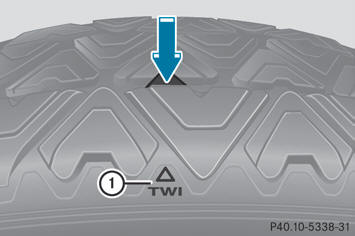Tire tread
 WARNING
WARNING
Although the applicable federal motor vehicle
safety laws consider a tire to be worn when
the tread wear indicators (TWI) become
visible at approximately 1/16 in (1.6 mm), we
recommend that you do not allow your tires
to wear down to that level. As tread depth
approaches 1/8 in (3 mm), the adhesion
properties on a wet road are sharply reduced.
Depending upon the weather and/or road
surface (conditions), the tire traction varies
widely.
Do not use tires that are excessively worn as the tire traction on wet road surfaces decreases significantly when the tread depth is less than 1/8 inch (3 mm).
Tread wear indicators (TWI) are required by law. Six indicators are positioned on the tire tread. They become visible as soon as a tread depth of approximately 1/16 inch (1.6 mm) has been reached. If this is the case, the tire is so worn that it must be replaced.
The recommended tread depth for summer tires is at least 1/8 inch (3 mm). The recommended tread depth for winter tires is at least 1/6 inch (4 mm).

Bar marking 1 for tread wear is integrated into the tire tread.
See also:
Coolant
Important safety notes
The coolant is a mixture of water and antifreeze/corrosion inhibitor. It performs
the following tasks:
corrosion protection
antifreeze protection
raising the boiling ...
Tire labeling overview
The following markings are on the tire in
addition to the tire name (sales designation)
and the manufacturer's name:
1. Uniform tire Quality Grading Standard
2. DOT, Tire Identification Num ...
Everything considered: integral Mercedes-Benz safety concept
The comprehensive Mercedes approach to integral safety also applies in the
new R-Class. This trailblazing safety philosophy goes well beyond compliance
with standardised crash test regulations. It ...
